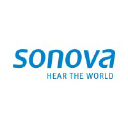Companies
Discover all trending biotech companies
Discover all trending biotech companies

Company Research Platform
Annual Revenue
$ 3,870,000,000
Global Employees
1,460
The Hearing Instruments segment focuses on the research, development, manufacturing, and distribution of hearing aids and related accessories. This segment utilizes advanced technologies such as digital signal processing, wireless connectivity, and artificial intelligence to enhance sound quality and user experience. R&D efforts are concentrated on miniaturization, improved battery life, and integration with smartphones and other devices. The segment addresses a wide range of hearing loss severities and offers products under brands like Phonak and Unitron. Market positioning emphasizes innovation, quality, and a comprehensive product portfolio, allowing Sonova to maintain a strong competitive advantage. Future opportunities include expanding into new markets and developing advanced features like real-time AI-powered sound enhancement. Regulatory compliance and clinical validation are critical aspects, ensuring the safety and efficacy of the devices. Partnerships with audiology clinics and healthcare providers are essential for distribution and patient support.
The Cochlear Implants segment is dedicated to providing solutions for individuals with severe to profound hearing loss. This involves the development, manufacturing, and commercialization of cochlear implant systems, including the implant itself and the external sound processor. Research and development efforts focus on improving sound processing algorithms, enhancing battery life, and developing advanced surgical techniques. Technologies used include microelectronics, biocompatible materials, and sophisticated signal processing. The therapeutic area is profound hearing loss, with the goal of restoring hearing and improving quality of life for patients. Market positioning is based on providing high-performance implants and comprehensive support services. Future growth opportunities include expanding into new markets and developing advanced features like improved speech processing and connectivity. Regulatory approvals and clinical trials are crucial for ensuring the safety and efficacy of the implants. Partnerships with surgeons, audiologists, and rehabilitation centers are essential for successful patient outcomes.
The Audiological Care segment focuses on providing professional hearing care services through a network of clinics and retail locations. This includes hearing tests, hearing aid fittings, and ongoing support and maintenance. R&D activities are focused on developing advanced diagnostic tools and improving the efficiency and effectiveness of hearing care services. Technologies and methodologies include advanced audiological testing equipment, real-ear measurements, and remote hearing aid adjustments. The therapeutic area is hearing loss of all types and severities, with the goal of improving patients' hearing and overall quality of life. Market positioning is based on providing high-quality, patient-centered care and a wide range of hearing aid brands. Future opportunities include expanding the clinic network, offering telehealth services, and developing new service offerings. Regulatory compliance and adherence to professional standards are critical. Partnerships with hearing aid manufacturers and insurance providers are essential for providing accessible and affordable care.
The Consumer Hearing segment focuses on the development, marketing, and sales of personal audio products, including headphones and headsets. This segment leverages advanced audio technologies, such as noise cancellation, Bluetooth connectivity, and high-fidelity sound reproduction, to deliver superior audio experiences. R&D efforts are focused on improving sound quality, enhancing comfort, and integrating advanced features like voice control and health tracking. The segment addresses the needs of consumers seeking high-quality audio products for various applications, including music listening, communication, and entertainment. Market positioning emphasizes innovation, design, and brand recognition. Future opportunities include expanding the product portfolio, entering new markets, and developing advanced features like personalized sound profiles. Regulatory compliance and adherence to industry standards are critical. Partnerships with retailers, technology companies, and content providers are essential for distribution and market reach.